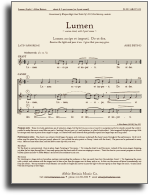Lumen
 (Receive the light and pass it on.)
(Receive the light and pass it on.)
Voicing: unison chant, with 3 part canonText: Latin aphorisms (Anonymous)
Duration: varies
Commissioned by: Waupaca High School Treble Clef 2012
Published by: Abbie Betinis Music Co., AB-071-01
Order online: Online order form
PROGRAM NOTE
 These two Latin aphorisms are of unknown origin, but since the first (Lumen accipe et imperti) is a motto for many schools around the world, I wanted to make the music sound like one part is "teaching" the next part. I also imagined the light growing a little bit stronger each time it passes from singer to singer, so I started with small intervals that gradually expand into larger leaps and long scales.
These two Latin aphorisms are of unknown origin, but since the first (Lumen accipe et imperti) is a motto for many schools around the world, I wanted to make the music sound like one part is "teaching" the next part. I also imagined the light growing a little bit stronger each time it passes from singer to singer, so I started with small intervals that gradually expand into larger leaps and long scales.|
Lumen Lumen accipe et imperti. Do ut des. |
(Light) Receive the light and pass it on. I give that you may give. |
LISTEN
Lumina (Kim Sueoka, Linda Kachelmeier, Angela Grundstad, Clara Osowski), live at Northwest Community Television, Brooklyn Park, MN.
(don't see the video above? Click here to listen to the audio file.)
PERFORMANCE NOTES
The Chant is an ostinato which begins the piece, and is meant to continue underneath the 3-part Canon throughout the performance. But the piece can be performed in many ways. Here are some ideas, and feel free to come up with your own!
The Chant
The Chant
- Try using the chant as a processional. Once in place, begin "layering in" the canon.
- Try using the chant to end the canon: so instead of the canon-singers dropping out after their last time through line 1, have each group join the chant until all voices are singing in unison.
- Print the chant in your concert program or church bulletin (please include "© Abbie Betinis") and invite your audience to join you.
- Try singing the piece as a four-part round, with the chant as part 1.
- Try standing in a large circle or horseshoe, perhaps surrounding the audience, so they can easily hear how the melodies 'travel.'
- Try beginning the canon with a soloist, and continue with the singers next to him or her, then the singers next to them, and so on. In this way the canon will travel symmetrically out from the soloist.
- For an evocative visual element, use candles or bright silk scarves to pass the 'light' to the next group as they begin the canon. Or join hands with the next group as they begin.
Performed by:
Calliope Women's Chorus; Richard Carrick, conductor (Saint Paul, Minnesota)
Cantus (Minneapolis, Minnesota)
Capriccio Youth Choirs (Columbus, Ohio)
Central Wisconsin Master Chorale (Stevens Point, Wisconsin)
De Coro, Coastal Sound's Adult Choir (Coquitlam, British Columbia, CANADA)
Florida International University Women's Chorus; Kathryn Longo, conductor (Miami, Florida)
Harrison School of the Arts Women’s Chorus; Kris Ridgley, conductor (Sanford, Florida)
InVocation (Minneapolis, Minnesota)
Kvennakór Háskóla Íslands, the Female Choir of Iceland University (Reykjavik, Iceland)
Lumina Women’s Ensemble (Saint Paul, Minnesota)
Meredith Chorale; Frances M. Page, conductor (Raleigh, North Carolina)
Michigan State University Singers; Andrew Minear, conductor (East Lansing, Michigan)
Ohio Women's High School Honor Choir; Lynda Hasseler, conductor (Westerville, Ohio)
Publisher’s Reading Session, National ACDA Conference (Salt Lake City, Utah)
Trinity Lutheran High School Bella Voce (Bend, Oregon)
Twin Cities Women's Choir; Jan Hunton, conductor (Minneapolis, Minnesota)
University of Minnesota Women's Chorus; G. Phillip Shoultz III, conductor (Saint Paul, Minnesota)
University of Minnesota-Morris Choirs (Morris, Minnesota)
(Have you performed this piece? Add your performance!)Cantus (Minneapolis, Minnesota)
Capriccio Youth Choirs (Columbus, Ohio)
Central Wisconsin Master Chorale (Stevens Point, Wisconsin)
De Coro, Coastal Sound's Adult Choir (Coquitlam, British Columbia, CANADA)
Florida International University Women's Chorus; Kathryn Longo, conductor (Miami, Florida)
Harrison School of the Arts Women’s Chorus; Kris Ridgley, conductor (Sanford, Florida)
InVocation (Minneapolis, Minnesota)
Kvennakór Háskóla Íslands, the Female Choir of Iceland University (Reykjavik, Iceland)
Lumina Women’s Ensemble (Saint Paul, Minnesota)
Meredith Chorale; Frances M. Page, conductor (Raleigh, North Carolina)
Michigan State University Singers; Andrew Minear, conductor (East Lansing, Michigan)
Ohio Women's High School Honor Choir; Lynda Hasseler, conductor (Westerville, Ohio)
Publisher’s Reading Session, National ACDA Conference (Salt Lake City, Utah)
Trinity Lutheran High School Bella Voce (Bend, Oregon)
Twin Cities Women's Choir; Jan Hunton, conductor (Minneapolis, Minnesota)
University of Minnesota Women's Chorus; G. Phillip Shoultz III, conductor (Saint Paul, Minnesota)
University of Minnesota-Morris Choirs (Morris, Minnesota)

